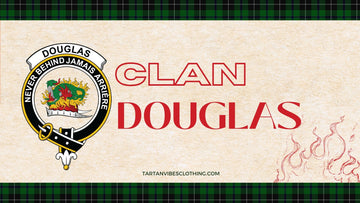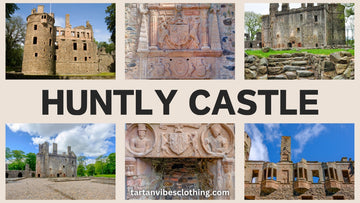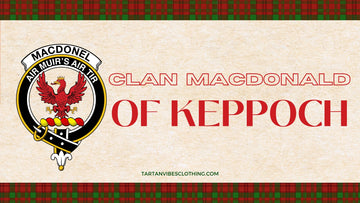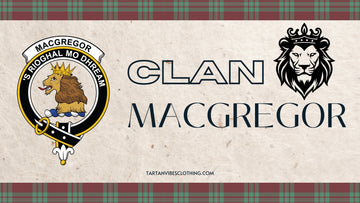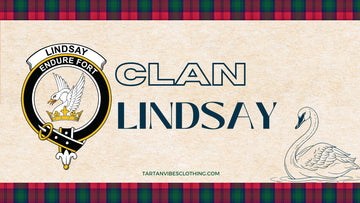Clan Douglas: Legacy of Resilience, Prominence and Influence
by Teejay Smith on Apr 15, 2024
Table of Content
Welcome to the stirring saga of Clan Douglas, a lineage woven into the very fabric of Scottish history. Shrouded in the mystique of early 12th-century origins, their story is one of resilience, power and enduring legacy. From their enigmatic beginnings to their pivotal role in Scotland's Wars of Independence, Clan Douglas has left an indelible mark on the nation's narrative. This exploration delves into their ancestral lands, iconic castles and unwavering spirit, revealing the secrets that shaped a clan forever etched in Scottish legend.
Origins of Clan Douglas
The origins of Clan Douglas are shrouded in a captivating mystery. While the first documented member, William de Douglas, appears in a charter from 1174, his lineage still needs to be clarified. Theories suggest the clan name itself might hold a clue. It could stem from the Gaelic phrase "dubh glas," meaning "black water" or "dark stream," potentially referencing their ancestral lands in the Scottish Borders.
Territory of Clan Douglas

Clan Douglas carved out a vast and influential domain across southern Scotland. Their strongholds, strategically positioned in regions like Douglasdale, Lanarkshire and Galloway, became testaments to their power. This strategic placement along the ever-volatile Scottish-English border wasn't simply symbolic. It allowed the clan to control trade routes significantly and bolster the nation's defenses. This in turn, fueled their rise to prominence in Scottish politics.
Clan Douglas History

Early History (12th - 15th Centuries)
Clan Douglas' origins remain shrouded in some mystery. Theories suggest descent from a Flemish knight, Theobald le Fleming, who acquired lands in Lanarkshire around the 12th century. His son, William, likely adopted the surname "Douglas" from the nearby Douglas Water. The clan rose to prominence throughout the 14th and 15th centuries, expanding its influence through strategic marriages and military prowess. Figures like Sir James "the Black Douglas" solidified their reputation for bravery by fighting alongside Robert the Bruce in the Wars of Scottish Independence.
Rise and Alliances (15th - 17th Centuries)
The 15th century saw Clan Douglas solidify its position through strategic alliances, most notably with the powerful Stewart Clan. This partnership strengthened the clan's territorial holdings and influence across Scotland. A marriage between a Douglas daughter and a Stewart Lord of Lorne symbolized the merging of two formidable houses. Victories like the Battle of Glen Fruin (1603) against rivals cemented Clan Douglas's power. However, this period also saw a dark stain on the clan's history with the infamous Black Dinner in 1440. William, the 6th Earl of Douglas, and his brother David were invited to a seemingly celebratory banquet at Edinburgh Castle by King James II. However, the meal turned deadly. A severed black bull's head, a symbol of execution, signaled their fate. Despite their pleas, the brothers were brutally murdered, a shocking act that forever tarnished relations between the Crown and Clan Douglas.
Despite this setback, the Clan Douglas played a significant role in Scottish affairs. They aligned themselves with the Royalist cause during the Scottish Civil War.
Challenges and Transformation (18th - 19th Centuries)
In the 18th and 19th centuries, they presented challenges. The aftermath of the Jacobite Rising (1745) resulted in land loss due to their Royalist allegiance. However, Clan Douglas persevered, adapting to changing times by engaging in new pursuits like trade and tourism. Clan members served in foreign armies, demonstrating their martial spirit beyond Scotland. Branches established themselves in countries like Sweden, highlighting the clan's global reach.
Modern Era and Beyond
The 20th century saw a revival with the establishment of the Clan Douglas Society. Today, the clan remains vibrant, actively preserving traditions and fostering a sense of community. Clan Douglas continues to uphold its legacy while embracing the modern world.
This revised version combines the clarity and details of the first section with the conciseness of the second. It also streamlines the "Global Impact" section within "Challenges and Transformation" for better flow.
📜 Please also see the history at http://clandouglassociety.org/history/
The Black Dinner: A Betrayal Steeped in Blood

The Clan Douglas, once one of Scotland's most powerful families, has a history filled with both glory and darkness. A prime example of this duality is the infamous "Black Dinner" at Edinburgh Castle. This event centered around William, the young and charismatic 6th Earl of Douglas, grandson of the legendary "Tynneman."
A Vulnerable King and a Deadly Plot
Young King James II found himself ruling Scotland under a divided regency. Sir William Crichton, the Chancellor, and Livingston of Callendar, the Governor of Edinburgh Castle, held the reins of power. However, both men harbored a growing fear: the rising influence of the charismatic young Earl of Douglas, William. They worried that his power could threaten their positions once William came of age. Seeing an opportunity, they hatched a sinister plot to eliminate the Douglas threat permanently.
A Feast Turns Deadly: Betrayal at the Black Dinner
What began as a joyous banquet within the castle walls quickly became a horrifying nightmare. William, the young Earl of Douglas, his younger brother David, and their attendant Malcolm Fleming were invited to a seemingly celebratory feast. Perhaps the young King James II found solace in their company, a welcome change from the usual court advisors.
However, the merriment swiftly transformed into a scene of utter brutality. As the dinner drew to a close, a severed black bull's head – a grim symbol of death – was presented before the boys. This gruesome sign signaled their impending doom. Despite the young Earl's desperate pleas for mercy, both brothers and their attendant were dragged outside and ruthlessly beheaded. Even the King's cries for their lives were ignored in a chilling display of cold-blooded murder. In a final act of brotherly love, William requested his brother be executed first, sparing him the sight of his execution.
The Douglas Resilience and the Fall of the Black Douglases
Despite the horrific Black Dinner, the Douglas spirit remained unbroken. William's successor, James the Gross, took over the Earldom. Though his reign ended with an unusual claim to fame – a stomach said to contain an incredible amount of fat upon his death in 1443 – the clan's power stayed strong.
However, their grip wouldn't last forever.
Just twelve years after the Black Dinner (1440), King James II, still wary of the Douglases' influence, lured and killed the 8th Earl. This act sparked a rebellion led by the Earl's brother, James. Unfortunately, the King swiftly crushed the uprising, weakening the Black Douglases. Desertion within their ranks and the loss of their strongholds culminated in their decisive defeat at Arkinholm. This battle marked the end of the Black Douglases as a dominant force. James, the rebel leader, died in exile, a tragic conclusion for this once-powerful branch of the clan.
A Twist of Fate: The rise of the Red Douglases
Despite its brutality, the Black Dinner inadvertently opened the door for another Douglas branch: the Red Douglases. George, the 4th Earl of Angus, rose to prominence as the Black Douglases fell. Ironically, he even led the King's forces at the Battle of Arkinholm, highlighting the complex and often divided nature of Clan Douglas throughout history.
The Black Dinner in Popular Culture:
The Black Dinner's chilling story has captivated audiences for centuries, finding its way into popular culture works like Neil Munro's historical novel "The Red Lion" and the gripping television series "Outlander." It serves as a potent reminder of the violence and political intrigue commonplace in medieval Scotland.
Clan Douglas Castle
The Clan Douglas, a prominent force in Scottish history, left its mark on the landscape through a network of castles scattered across the country. These fortifications served as centers of power, symbols of resilience, and sometimes even witnessed pivotal moments in Scottish history. Here's a glimpse into some of the most notable Clan Douglas castles:
Douglas Castle (South Lanarkshire): Once the seat of Sir James Douglas, this castle was demolished in the 20th century due to unstable foundations. However, its legacy lives on in historical accounts and Sir Walter Scott's novel "Castle Dangerous".

Aberdour Castle (Fife): Originally built in the 12th century, this semi-ruin offers a glimpse into early castle architecture.

Dalkeith Castle (Midlothian): Initially built by the Grahams, this strategic castle passed to the Douglases in the 14th century. Though destroyed by the English, it was rebuilt in the 16th century and eventually transformed into a palace. Today, it remains in the Buccleuch family.

Drumlanrig Castle (Dumfries and Galloway): This magnificent castle represents the grandeur of the Douglases. Built in the 17th century, it remains a private residence within the Buccleuch family estate.

Hermitage Castle (Roxburghshire): Originally constructed around 1250, it changed hands frequently due to its strategic location. The Douglases held it for a period, and the ruins still stand as a testament to its turbulent past.

Threave Castle (Dumfries and Galloway): Built on an island on the River Dee, this formidable castle withstood multiple sieges, including one overseen by King James II himself.

Clan Douglas Coat Of Arms
The Clan Douglas coat of arms is a heraldic emblem that represents the Clan Douglas, a prominent Scottish clan. It consists of a shield, helmet, crest, mantling, and motto.
The shield is silver with a bloody heart in the center. The heart is believed to represent the heart of Robert the Bruce, King of Scots, which Sir James Douglas attempted to carry to the Holy Land after the king's death.
The crest is a salamander emerging from flames. The salamander is a mythical creature that was said to be able to live in fire. It is a symbol of courage and resilience.
The motto is "Jamais Arriere" which is French for "Never Behind". This motto reflects the clan's reputation for bravery and determination.

Clan Douglas Crest
Gaelic Name: Dubhghlas
Crest: On a chapeau, Gules, furred Ermine, a salamander, Vert, encircled with flames of fire, Proper
Motto: Jamais Arriere (Never behind)
Origin of Name: Placename, Lanark (Black stream)
Lands: Lanarkshire, Galloway, Dumfriesshire and Angus
Clan Chief: None, armigerous clan

At the heart of the Clan Douglas crest lies the depiction of a salamander, symbolizing the clan's indomitable courage and resilience. This emblem embodies their ability to confront and conquer adversity throughout history, emerging more robust from every challenge. The imagery of the salamander emerging unscathed from flames signifies the clan's capacity to overcome obstacles, demonstrate bravery in battle, and endure across generations. Through this enduring symbol, the crest inspires pride and reinforces the clan's legacy of fortitude in Scottish history.
Clan Douglas Tartan
The Clan Douglas tartan is a bold emblem woven in threads of history that resonates with the unyielding spirit of this prominent Scottish clan.
Colors and Meaning:
Green: The primary hue evokes the verdant Scottish highlands, the ancestral lands of the Douglases.
Blue: Speaks volumes of their loyalty and unwavering resolve.
White: Adds a hint of elegance, reflecting the clan's multifaceted character.
Variations:
The Douglas tartan boasts five distinct variations: Modern, Ancient, Weathered, Grey Modern, and Grey Ancient. Each variation offers a subtle twist on the core color scheme, allowing wearers to express their individuality while staying true to their clan heritage.






Wearing the Tartan:
Beyond the traditional kilt, sash, or scarf, the Clan Douglas tartan finds a modern expression in polo and button-down shirts. This allows a versatile way to connect with your heritage, whether attending a formal event or simply showcasing your clan pride in everyday wear.
In a striking contrast to the bold colors of the Douglas tartan, the Clan Hamilton tartan exudes a sophisticated air. Deep greens and rich blues intertwine with subtle hints of black, reflecting the clan's ancestral homelands.
Explore the timeless traditions of Clan Douglas through our collection of tartan products on our website. And bring a piece of the clan's history into your present.
Clan Douglas Chieftaincy
Archibald Douglas, the first Duke of Douglas, was the last official Clan Douglas Chieftain. His passing in 1761 marked the end of a lineage. The title then transitioned to James, the 7th Duke of Hamilton. However, the Dukes of Hamilton, also known as Douglas-Hamilton, inherited the chiefdom but cannot formally claim the title. This restriction arises from a requirement by the Lord Lyon King of Arms, the ultimate authority on Scottish heraldry. The Duke must adopt the singular name "Douglas" to assume the Chieftaincy, which they haven't done.
This unresolved naming issue leaves the Clan Douglas Chieftaincy in question. Despite the absence of an officially recognized Chief, the Clan Douglas Society thrives as a global community dedicated to preserving the clan's rich heritage.
The Famous People of Clan Douglas
The Clan Douglas boasts a rich history filled with prominent figures who left their mark on war and law.
Sir James Douglas (d. 1330): Also known as "Good Sir James" or "Black Douglas," Sir James was a renowned Scottish knight and military commander during the Wars of Independence. Fighting valiantly alongside Robert the Bruce, he left a lasting legacy. Notably, after Robert the Bruce's death, Sir James famously attempted to fulfill the king's wish to be buried in Jerusalem, carrying his embalmed heart on a crusade.
William O. Douglas (1898-1980): An American jurist and politician, Douglas served a record-breaking 36 years as an associate justice of the Supreme Court. A champion of individual liberties, his legal decisions and prolific writings on history, politics, and international relations continue to shape American law.
Entertainment:
Kirk Douglas (1916-2020): A Hollywood legend, Kirk Douglas starred in iconic films like "Spartacus" (Academy Award nominee) and "20,000 Leagues Under the Sea."
Michael Douglas (born 1944): Following in his father's footsteps, Michael Douglas became a renowned actor and producer, winning Academy Awards for his roles in "Wall Street" and "One Flew Over the Cuckoo's Nest."
Sports:
Gabby Douglas (born 1995): A gymnastics sensation, Gabby Douglas captured the hearts of millions with her gold medal performance at the 2012 Olympic Games.
Additionally, other notable Douglas figures have left their mark in various fields.
The Clan Douglas Society
The Clan Douglas Society is a vibrant community dedicated to preserving and celebrating the rich heritage of the Douglas clan. Founded with the mission of connecting Douglas descendants worldwide, the society offers a platform for members to:
Explore their ancestry: Access exclusive resources and connect with experienced genealogists to delve into your family history.
Share stories and traditions: Connect with fellow members online and at gatherings to share stories, celebrate the shared heritage and learn about the Douglas legacy.
Immerse yourself in Scottish culture: Participate in cultural events, Highland Games and educational initiatives that keep Scottish traditions alive.
Benefits of Membership:
Access to a wealth of genealogical resources and research tools.
Invitations to exclusive clan gatherings and events worldwide.
Connection with a global network of Douglas descendants.
Regular newsletters and publications featuring clan history and news.
Conclusion
Clan Douglas, a cornerstone of Scottish history, is a testament to resilience, power, and enduring legacy. From their 12th-century origins to their pivotal role in Scotland's Wars of Independence, the Douglases have left an indelible mark on the nation's narrative. Their iconic castles, fierce determination and unwavering loyalty to Scotland continue to inspire generations.
Beyond the battlefield, the Clan Douglas legacy extends to shaping Scottish culture. Their influence on politics, society, and even architecture continues to be felt today. With its global reach, the vibrant Clan Douglas Society ensures that the clan's spirit of strength and pride thrives for generations to come.
Frequently Asked Questions
What Scottish clan does Douglas belong to?
Clan Douglas is a Lowland clan, taking its name from the Gaelic 'dubh glas' meaning 'black water'. In the early 12th century, 'Theobald le Fleming' was granted the Douglas lands in Lanarkshire, by the Abbot of Kelso, and his son was styled Lord of Douglas. He was the first man to assume the name.
Why was the Black Douglas called the Black Douglas?
James Douglas, Lord of Douglas - Simple English Wikipedia ...To the people of Scotland he was "the Good Sir James". He was now one of the king's greatest supporter and a model of chivalry. But James had black hair and a reputation so feared by the English they named him "the Black Douglas."
What was the Douglas family motto?
Their influence was so great that they posed a threat to the Scottish monarchy, and their loyalty was often tested. But the clan remained steadfast, living by their motto of Jamais arrière (Never Behind) and persevering through even the toughest of times.
What is the origin of the Douglas family?
Douglas, occasionally spelt Douglass, is a Scottish surname. It is thought to derive from the Scottish Gaelic dubh glas, meaning "black stream". There are numerous places in Scotland from which the surname is derived. The surname has developed into the given name Douglas.

